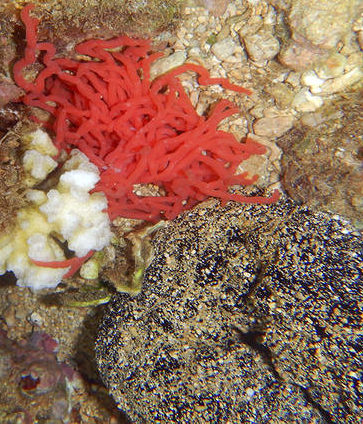Published in the Ocean Watch column, Honolulu Star-Advertiser © Susan Scott
September 1, 2018
During a swim I took before the recent rain runoff clouded our waters, I found, in about 5 feet of water, a clump of tubules so red I thought it must be a child’s lost toy. The soft, solid tubes, each about a quarter-inch wide and about 3 inches long, were loosely connected in the center. This mass, which fit in my palm, was clearly something organic, but I didn’t have a clue as to its identity.
Part of the fun of writing this column is that people in Hawaii are happy to help me with identification, one being Julie Bailey-Brock, head of a research center called “The WormLab” at the University of Hawaii at Manoa. I sent Julie the pictures, and she emailed back, “A bit strange. … My thoughts … red material is probably the gonads of a sea cucumber. … There is one in the photo near the red mass.”
 The red tubules are likely the gonads of the black sea
The red tubules are likely the gonads of the black sea
cucumber curled up below and coated with sand. This is
Hawaii’s most common large sea cucumber, Holothuria atra.
©2018 Susan Scott
Sea cucumbers have red gonads? Who knew?
Researchers knew. Several papers I found mentioned red gonads in mature female sea cucumbers, a subject under more study than you might imagine. The creatures are under scrutiny because Holothurians, sea cucumbers’ class name, are in high demand in China, Indonesia and other countries where they are food known as “beche-de-mer,” a corruption of a Portuguese term meaning sea worm.
Because nature’s little vacuum cleaners are being overfished in the Indian and Pacific oceans, commercial fishers are now collecting species from the Mediterranean and Atlantic. In efforts to make all sea cucumber takes sustainable, researchers are studying the creatures’ reproductive systems.
Hawaii had recent problems with over-collecting, but legislators thankfully put a stop to it. Since 2016 it has been illegal to sell most sea cucumber species. Exceptions are taking up to 10 per day for personal use, and each year fishers can collect up to 3,600 individuals of two small species to sell in the aquarium trade.
So why might a sea cucumber’s sex organs be lying on the ocean floor? A predator likely threatened the sausagelike animal. And when sea cucumbers get threatened, they spill their guts.
Really. It’s a type of casting off of body parts that some animals use to save themselves. In this case, though, it’s more than losing and arm or a leg. When a sea cucumber senses impending death, it poops out all of its organs. The predator is either repelled by the heap and takes off or gets tangled in sticky threads and dies.
It’s hard to imagine an animal can survive without its innards, but sea cucumbers that have lost their entire digestive, respiratory and reproductive organs grow new ones in a few weeks.
Even though I’ve been snorkeling, diving and looking up marine animal facts for decades, the ocean still stumps me. But then, that’s the fun of it.
Thank you, Julie. Next week, a real worm.